Resident Crews of the International Space Station (ISS)
![]()
ISS: Expedition 28 |
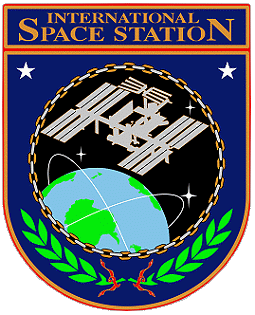 |
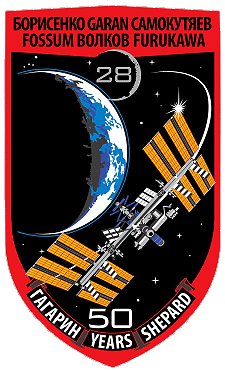 |
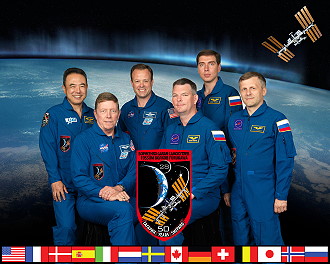 |
alternative crew photo |
![]()
Crew, launch- and landing data
| No. | Nation | Surname | Given names | Position | Spacecraft (launch) |
Launch date |
Launch time |
Spacecraft (landing) |
Landing date |
Landing time |
Mission duration |
Orbits |
| 1 | Borisenko | Andrei Ivanovich | ISS-CDR | Soyuz TMA-21 | 04.04.2011 | 22:18:20.115 UTC | Soyuz TMA-21 | 16.09.2011 | 03:59:43.8 UTC | 164d 05h 41m 24s | 2576 | |
| 2 | Samokutyayev | Aleksandr Mikhailovich | Flight Engineer-1 | Soyuz TMA-21 | 04.04.2011 | 22:18:20.115 UTC | Soyuz TMA-21 | 16.09.2011 | 03:59:43.8 UTC | 164d 05h 41m 24s | 2576 | |
| 3 | Garan | Ronald John, Jr. | Flight Engineer-3 | Soyuz TMA-21 | 04.04.2011 | 22:18:20.115 UTC | Soyuz TMA-21 | 16.09.2011 | 03:59:43.8 UTC | 164d 05h 41m 24s | 2576 | |
| 4 | Volkov | Sergei Aleksandrovich | Flight Engineer-4 | Soyuz TMA-02M | 07.06.2011 | 20:12:44.924 UTC | Soyuz TMA-02M | 22.11.2011 | 02:24:50 UTC | 167d 06h 12m 05s | 2614 | |
| 5 | Furukawa | Satoshi | Flight Engineer-5 | Soyuz TMA-02M | 07.06.2011 | 20:12:44.924 UTC | Soyuz TMA-02M | 22.11.2011 | 02:24:50 UTC | 167d 06h 12m 05s | 2614 | |
| 6 | Fossum | Michael Edward | Flight Engineer-6 | Soyuz TMA-02M | 07.06.2011 | 20:12:44.924 UTC | Soyuz TMA-02M | 22.11.2011 | 02:24:50 UTC | 167d 06h 12m 05s | 2614 |
unofficial Backup Crew
| No. | Nation | Surname | Given names | Position |
| 1 | Shkaplerov | Anton Nikolayevich | ISS-CDR | |
| 2 | Ivanishin | Anatoli Alekseyevich | Flight Engineer | |
| 3 | Burbank | Daniel Christopher | Flight Engineer | |
| 4 | Kononenko | Oleg Dmitriyevich | Flight Engineer | |
| 5 | Pettit | Donald Roy | Flight Engineer | |
| 6 | Kuipers | André | Flight Engineer |
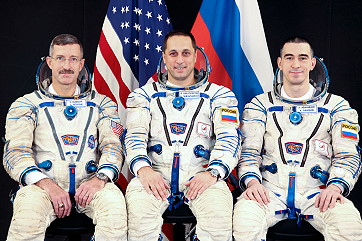 |
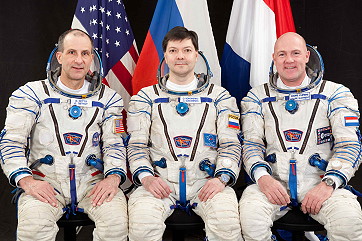 |
 |
Expedition Report
|
Launch from the Baikonur Cosmodrome (Sergei
Volkov, Michael
Fossum and Satoshi
Furukawa with
Soyuz
TMA-02M). Aleksandr
Samokutyayev, Andrei
Borisenko and Ronald
Garan were onboard since April 06, 2011 (arrival with
Soyuz
TMA-21). ISS Expedition 28 began with the undocking of spacecraft Soyuz TMA-20 on May 23, 2011 at 21:35:17 UTC. The former Expedition 27 (Dmitri Kondratiyev, Paolo Nespoli and Catherine Coleman) returned safely to Earth. With the arrival of Soyuz TMA-02M on June 09, 2011 at 21:18 UTC the Expedition 28 became a six-person-crew. Soyuz TMA-02M carried Sergei Volkov, Michael Fossum and Satoshi Furukawa to the space station. On 20 June 2011, the European Space Agency's robotic cargo ship Johannes Kepler disengaged from the ISS, having been docked since February 2011. On June 21, 2011, the ATV was deorbited, burning up in the atmosphere over the southern Pacific Ocean at around 21:44 UTC. A Russian Progress cargo ship, designated M-11M was launched on June 21, 2011 to resupply and deliver equipment to the International Space Station. Progress M-11M transferred more than 2.5 tons of cargo to the Space Station, including food, water, scientific hardware, propellant, and cargo. The cargo ship docked with the Zvezda service module of the Space Station at 16:37 UTC on June 23, 2011. The docking occurred 245 miles (395 km) above eastern Kazakhstan. The four attitude thrusters of Progress M-11M were fired on July 01, 2011 to reboost the Space Station. After the burn, the ISS orbit was raised by 3.5 km and achieved 388.3 km. The purpose of the reboost was to gain altitude and set up phasing conditions for Space Shuttle Atlantis' STS-135 (ULF) mission. Progress M-11M undocked at 09:37 UTC on August 23, 2011 on was deorbited on September 01, 2011. Space Shuttle STS-135 docked with the International Space Station on July 10, 2011. The STS-135 (ISS ULF-7 MPLM Raffaello) mission's primary cargo was the Multi-Purpose Logistics Module (MPLM) Raffaello and a Lightweight Multi-Purpose Carrier (LMC), which were delivered to the International Space Station (ISS). The flight of Raffaello marked the only time that Atlantis carried an MPLM. The module was filled with supplies and spare parts to sustain station operations once the shuttles are retired, transport of the Robotic Refueling Mission (RRM), an experiment designed to demonstrate and test the tools, technologies and techniques needed to robotically refuel satellites in space, even satellites not designed to be serviced. Among the objectives was the returning of an ammonia pump that recently failed on the station. Engineers want to understand why the pump failed and improve designs for future spacecraft. This is the final flight for shuttle Atlantis and the Space Shuttle Program. The Raffaello Multi-Purpose Logistics Module (MPLM) is one of three differently named large, reusable pressurized elements, carried in the space shuttle's cargo bay, used to ferry cargo back and forth to the station. Raffaello includes components that provide life support, fire detection and suppression, electrical distribution and computers when it is attached to the station. The cylindrical logistics module acts as a pressurized "moving van" for the Space Station, carrying cargo, experiments and supplies for delivery to support the six-person crew on board the station. The module also returns spent Orbital Replacement Units (ORUs) and components. Each MPLM module is 21 feet (6.4 meters) long and 15 feet (4.6 meters) in diameter - the same size as the European Space Agency's (ESA's) Columbus module. On the STS-135 mission, Raffaello will carry eight Resupply Stowage Platforms (RSPs), two Intermediate Stowage Platforms (ISPs), and six Resupply Stowage Racks (RSRs) and one Zero Stowage Rack. There are no system or express racks flying up on this MPLM. All the racks are stowage racks (RSRs, RSPs, ISPs) so NASA can carry the maximum cargo (spare units, spare parts, food, etc.) up to keep the station stocked up for one year. Located behind Raffaello in the space shuttle payload bay is the Lightweight Multi-Purpose Experiment Support Structure Carrier (LMC), a non-deployable cross-bay carrier providing launch and landing transportation. The LMC is a light-weight shuttle stowage platform that only weighs 946 pounds (429 kg). The launch weight of the LMC is 2,918 pounds (1,324 kg) and the return weight with the pump module will be 3,530 pounds (1,601 kg). STS-135 will be the last of seven missions for the workhorse LMC carriers. The LMCs were developed for use by station from existing Space Shuttle Multi-Purpose Equipment Support Structure, MPESS, hardware to carry Launch-On-Need, LON, and Orbital Replacement Units, ORUs, for space station. GSFC and ATK have provided the sustaining engineering support for all the LMC missions, including carrier management, refurbishment, analysis, documentation and safety. During ascent, the LMC will be carrying a Robotic Refueling Mission (RRM) on the bottom. During descent, the LMC will be carrying an ammonia pump that will be analyzed to determine its cause for failure. A special adapter plate, built by Boeing, had to be installed on the LMC so the large pump could be carrier on the top of the LMC. Additional modifications had to be made to accommodate the Pump Module Assembly (PMA) which included removing the aft winch, the wireless video antenna, and all handrails in the aft bulkhead of the space shuttle cargo bay. This will be first time that a pump module has been carried on an LMC. The PMA will be removed from External Storage Platform 2 where it has been stored. NASA's Robotic Refueling Mission (RRM) is an external International Space Station experiment designed to demonstrate and test the tools, technologies and techniques needed to robotically refuel and repair satellites in space, especially satellites that were not designed to be serviced. A joint effort between NASA and the Canadian Space Agency (CSA), RRM will be the first in-orbit attempt to test robotic refueling and repair techniques for spacecraft not built with in-orbit servicing in mind. It is expected to reduce risks and lay the foundation for future robotic servicing missions. RRM also marks the first use of Dextre beyond the planned maintenance of the space station for technology research and development. After Atlantis docks with station, RRM will be transferred during a spacewalk to Dextre's Enhanced Orbital Replacement Unit Temporary Platform (EOTP). Following the shuttle's departure, RRM will remain on the EOTP, and Dextre and Canadarm2 will transfer RRM to its permanent location ExPRESS Logistics Carrier 4 (ELC-4). The ELC will provide command, telemetry and power support for the experiment. RRM operations will be entirely remotely controlled by flight controllers at NASA's Goddard Space Flight Center in Greenbelt, Md., Johnson Space Center in Houston, Marshall Space Flight Center in Huntsville, Ala., and the CSA's control center in St. Hubert, Quebec. Once the RRM module is securely mounted to the space station's ELC-4 platform, mission controllers will direct the Dextre robot, the space station's Canadian, twin-armed "handyman", to retrieve RRM tools from the module and perform a full set of refueling tasks. Dextre will use the RRM tools to cut and manipulate protective blankets and wires, unscrew caps and access valves, transfer fluid, and leave a new fuel cap in place. At one stage of the mission, Dextre will use RRM tools to open up a fuel valve, similar to those commonly used on satellites today, and transfer liquid ethanol across a robotically mated interface via a sophisticated robotic fueling hose. Each task will be performed using the components and activity boards contained within and covering the exterior of the RRM module. The experiment will also demonstrate general space robotic repair and servicing operations. Completing the demonstration will validate the tool designs (complemented with cameras), the fuel pumping system, and robotic task planning, all of which will be used during the design of a potential future refueling spacecraft. The Pump Module (PM) is part of the station's complex Active Thermal Control System (ATCS), which provides vital cooling to avionics, crew members and payloads. The station has two independent cooling loops. The external loops use an ammonia-based coolant and the internal loops use a water-based coolant. At the heart of the ATCS is the Pump Module, which provides circulation, loop pressurization, and temperature control of the ammonia. The PM pumps the ammonia through the external system to provide cooling. Heat is generated by the electronic boxes throughout the station and eventually rejected into space via the radiators. The major components in the PM include a Pump and Control Valve Package (PCVP), an accumulator, isolation and relief valves, and temperature, flow, and pressure sensors. The accumulator within the PM works in concert with the Ammonia Tank Assembly (ATA) accumulators to compensate for expansion and contraction of ammonia caused by the temperature changes and keeps the ammonia in the liquid phase via a fixed charge of pressurized nitrogen gas on the backside of its bellows. Manufactured by Boeing, the pump module weighs 780 pounds (354 kg) and measures approximately 5 ½ feet (69 inches = 1.7 meters) long by 4 feet (50 inches = 1.2 meters) wide with a height of 3 feet (36 inches = 0.9 meters). On this mission, the PM is being returned for further analysis and investigation of the failure that occurred on July 31, 2010. A new PM was installed on August 16, 2010, and has been performing well. The failed PM will undergo extensive testing and evaluation in Houston. The PCVP will be sent to Hamilton Sundstrand for thorough testing and evaluation. The current theory for the cause of the failure is an electrical issue within the PCVP unit. After the root cause is determined to be either systemic to the PM or specific to this unit, NASA will determine the follow-on actions, if any. The space station has three spare pump modules in orbit. Only four astronauts were assigned to this mission, versus the normal six or seven, because there were no other shuttles available for a rescue following the retirement of Discovery and Endeavour. If the shuttle was seriously damaged in orbit, the crew would have moved into the International Space Station and returned in Russian Soyuz capsules, one at a time, over the course of a year. All STS-135 crew members were custom-fitted for a Russian Sokol space suit and molded Soyuz seat liner for this possibility. The reduced crew size also allowed the mission to maximize the payload carried to the ISS. It was the only time that a Shuttle crew of four flew to the ISS. The last shuttle mission to fly with just four crew members occurred 28 years earlier: STS-6 on April 04, 1983 aboard Space Shuttle Challenger. Atlantis docked with the ISS Pressurized Mating Adapter-2 at 15:07 UTC as the two orbited 220 miles (350 km) over the South Pacific Ocean east of New Zealand. This was Atlantis's 19th docking to a Space Station. A series of leak checks were done on both sides of the hatches, before they were opened at 16:47 UTC. Shortly afterwards, the shuttle crew floated into the station's Harmony module at 16:55 UTC. After a brief welcoming ceremony by the station crew, Atlantis's astronauts received the standard station safety briefing. The crew then got to work with Christopher Ferguson and Douglas Hurley using the shuttle arm to take its OBSS from the station's Canadarm2 operated by Ronald Garan and Satoshi Furukawa. The station arm had plucked the OBSS from its stowage position on the shuttle cargo bay sill. The handoff was to prepare to use the boom for any shuttle heat shield late inspections if required. Sandra Magnus worked with TV setup and Rex Walheim transferred spacewalk gear. On flight day 4 working at the International Space Station's Cupola robotic workstation, Atlantis Pilot Douglas Hurley and Mission Specialist Sandra Magnus used Canadarm2 to grapple the 12.5-ton, 21 foot (6.4 meters) long, 15 foot (4.6 meters) wide Raffaello multi-purpose logistics module, which was nestled in the shuttle cargo bay. They lifted Raffaello out and attached it to the Earth-facing port of the station's Harmony node. Raffaello was packed with more than 8,000 pounds (3,629 kg) of spare parts, spare equipment, food and other supplies that will sustain space station operations through 2012. Raffaello carried eight Resupply Stowage Platforms (RSPs), two Intermediate Stowage Platforms (ISPs), six Resupply Stowage Racks (RSRs) and one Zero Stowage Rack. Because Atlantis launched on time with a full load of onboard consumables for its electricity-generating fuel cells, and due to power saving operations employed during the first three days, on Flight Day 4, NASA's managers approved a one-day mission extension. According to NASA, the mission was extended primarily to allow the crew spent more time on cargo transfers. While the docking of STS-135 an EVA was performed by Michael Fossum and Ronald Garan on July 12, 2011 (6h 31m). The main tasks of this EVA were: transfer of a failed ammonia pump to the shuttle cargo bay, transfer of the Robotic Refueling Mission (RRM) to the station and place an experiment on ELC-2 for long-duration exposure. STS-135 primary cargo was the Multi-Purpose Logistics Module (MPLM) Raffaello and a Lightweight Multi-Purpose Carrier (LMC). Michael Fossum and Ronald Garan began the STS-135 spacewalk with the highest priority task - retrieval of the failed pump module. The equipment was prepared for return to Earth during previous spacewalks, and was stored on external stowage platform 2 at the Quest airlock. Michael Fossum made his way to the platform and installed two backup tools, called Contingency Operations Large Adapter Assembly Tools - or COLTs - onto the hardware that held the pump module in place. The COLTs allowed the crew to access contingency bolts on the back of the hardware, in case the spacewalkers run into problems using the primary bolt to install the pump module in the shuttle's cargo bay. While Michael Fossum worked with the COLTs, Ronald Garan met the station's robotic arm at the stowage platform, and installed a foot restraint on it so that he could climb into it and free up his hands to carry the pump module back to Atlantis. To remove the pump module from the stowage platform, Ronald Garan grabbed onto the pump module, while Michael Fossum released the bolt holding it in place. That allowed Ronald Garan to lift the module off of the stowage platform and fly it to the shuttle's cargo bay. Once there, Ronald Garan drove the same bolt to attach the module to the carrier inside the cargo bay, securing it for the return to Earth. Michael Fossum and Ronald Garan then switched places, giving Michael Fossum a turn on the end of the robotic arm. Then Michael Fossum held the Robotic Refueling Mission experiment, while Ronald Garan released the bolt attaching it to the cargo bay. Michael Fossum lifted it out, and flew it via robotic arm to the Special Purpose Dexterous Manipulator, or Dextre, as the robot is called, on the Destiny laboratory. He bolted the experiment onto platform on Dextre used to hold equipment and spare parts that Dextre is working with. Ronald Garan assisted. With those major tasks done, Michael Fossum climbed off of the robotic arm and removed the foot restraint that Ronald Garan installed, while Ronald Garan deployed a segment on the Materials International Space Station Experiment 8 (or MISSE 8), which was installed during STS-134. Because that experiment was situated near the Alpha Magnetic Spectrometer (AMS), which was also installed on STS-134, and the thermal covers on the AMS were expected to need some time to air out once the experiment was installed, the STS-134 crew was asked not to expose this segment of the experiment until the gases in the AMS cover had some time to dissipate. To deploy it now, Ronald Garan installed an Optical Reflector Materials Experiment that was brought up on Endeavour's middeck during STS-134 into a socket on MISSE 8 and remove its protective cover. On flight day 6 Atlantis's crew focused on unpacking supplies from the Raffaello MPLM. The crew started the day 26 percent through the combined 15,069 pounds (6,835 kg) of cargo to transfer in or out of Raffaello. The MPLM was launched with 9,403 pounds (4.265 kg) of cargo and it was expected to return 5,666 pounds (2,570 kg) when Atlantis landed. The supplies and equipment that Atlantis astronauts delivered to the orbiting outpost was expected to keep the station well supplied through 2012. The crew had some help from the station crew of Andrei Borisenko, Sergei Volkov and Satoshi Furukawa in the transfer operations. Crew members also opened the Pressurized Mating Adapter (PMA-3), attached to the Tranquility node, and stored some of the material from Raffaello there. On flight day 7 the shuttle astronauts went to sleep as planned but were awakened by the sound of a master alarm on board Atlantis at 22:07 UTC. The tone signaled a failure with one of Atlantis's five IBM AP-101 General Purpose Computers (GPCs) No. 4. The alarm prompted Commander Christopher Ferguson to head to Atlantis and evaluate the issue. GPC-4 was running system management software at the time of failure. Christopher Ferguson with the help of Ground Control later transferred the failed GPC's programs onto GPC-2. The transfer took about 45 minutes, bypassing an expected period of loss of signal by utilizing communications at White Sands, New Mexico. After activating GPC-2 and with Atlantis in good shape, Christopher Ferguson and other crew members went back to sleep. Early on the next day, Atlantis commander Christopher Ferguson and pilot Douglas Hurley re-loaded software and successfully restarted the GPC-4. Flight controllers in Houston also downloaded data dumps to carefully monitor the computer to make sure that it was running normally. While Christopher Ferguson and Douglas Hurley focused on computer troubleshooting, Mission Specialists Sandra Magnus and Rex Walheim together with the station crew continued to work on cargo transfers between Atlantis the Space Station. Rex Walheim also transferred EMU/airlock items to Atlantis that won't be needed in the post-shuttle era. Early on the flight day 9, Commander Christopher Ferguson and Pilot Douglas Hurley also spent some time working to successfully repair the door that gives the crew access to the LiOH canisters. Mission Specialist Sandra Magnus spent about an hour and a half in the morning taking microbial air samples on various locations in the space station. The collected samples will be returned for study and further analysis. Sandra Magnus also worked the Japanese Experiment Module Remote Manipulator System (JEM RMS). Mission Specialist Rex Walheim along with station crew member Michael Fossum continued work with spacewalking equipment in the Quest airlock. Some of them will be left on the station, and will be utilized during an upcoming Russian spacewalk on August 03, 2011. Douglas Hurley working with station crew member Ronald Garan stored some of the cargo in Atlantis's middeck to be returned. Since no astronaut was riding in the mid-deck, on the way back, it was expected to be fully packed with 1564 pounds of cargo. Among cargo brought to the space station, 2281 pounds were also in the mid-deck. After their midday meal on flight day 10, Mission Specialist Sandra Magnus and Commander Christopher Ferguson worked a little over an hour continuing to move experiments and equipment to and from Atlantis's middeck. At the end 84% of middeck transfers were completed. The crew transferred a new science refrigerator (GLACIER) from the Shuttle's middeck to the Space Station. Another couple of noteworthy middeck payloads that were transferred included the mass spectrometer in the mass constituent analyzer, a device in the U.S. segment that samples air from different parts of the station to determine its constituents. Flight Engineer Ronald Garan removed the broken spectrometer and moved it to Atlantis's middeck for return. The suspect gyroscope in the TVIS treadmill located in the Russian segment removed by Flight Engineer Sergei Volkov was also placed in the middeck. The STS-135 crew returned the MPLM back to Atlantis's payload bay on flight day 12, closed the hatches between the Space Station and the Shuttle and prepared for next day's undocking. Beginning at 05:03 UTC, the hatches separating Raffaello MPLM and the ISS were closed. With station's Canadarm2 locked onto Raffaello, commands were issued at 10:14 UTC to begin the releasing operations of the 16 motorized bolts holding the MPLM in place on the station's Node 2. Arm operators, Mission Specialist Sandra Magnus and Pilot Douglas Hurley working inside the cupola, un-berthed Raffaello at 10:48 UTC and moved it back to Atlantis's payload bay. The move was completed by around 11:48 UTC. The securing of the Raffaello in the shuttle's payload bay marked the 10th and final transfer of an MPLM in the history of the Space Shuttle program. Shortly after hatches between the two spacecraft were closed, the crew returned to Atlantis. They carried out tasks to prepare for the undocking from the Space Station. Christopher Ferguson and Douglas Hurley installed the centerline camera while hatch leak checks were still under way. Douglas Hurley and Rex Walheim also checked out the rendezvous tools. On July 19, 2011 STS-135 undocked as the last Space Shuttle from the ISS and moved to a distance of about 450 feet (137.2 meters), where Douglas Hurley began to fly around the station. Atlantis circled the shuttle around the station at a distance of about 600 feet (182.9 meters). The shuttle crew took detailed photographs of the external structure of the station, which served as important documentation for the ground teams in Houston to monitor the orbiting laboratory. Once the shuttle completed 1.5 revolutions of the complex, Douglas Hurley fired Atlantis's jets to leave the area. Nearly two hours after undocking a second firing of the engines took Atlantis farther away from the station. The second EVA by Sergei Volkov and Aleksandr Samokutyayev occurred on August 03, 2011 (6h 23m) to move a small crane, install a communications terminal and remove and inspect antennas. Other tasks included installing a materials science experiment and deploying a micro-satellite. Progress M-12M was launched at 13:00:11 UTC on August 24, 2011. Approximately 325 seconds into flight, a malfunction was detected in the RD-0110 engine powering the Blok I third stage of the Soyuz-U rocket, which caused the onboard computer to terminate the flight through thrust termination. As a result, the vehicle failed to achieve orbit, reentering over the Altai Republic region of Russia. It was the first failure of a Progress spacecraft since launches began in 1978. Progress M-12M was carrying 2,670 kilograms (5,890 lb) of cargo to the International Space Station. This included 420 kilograms (930 lb) of water, 50 kilograms (110 lb) of oxygen, and 996 kilograms (2,196 lb) of fuel. Of the fuel, 746 kilograms (1,645 lb) would have been used to refuel the ISS, and the remaining 250 kilograms would have been expended by the Progress spacecraft whilst docked, in its three reboost maneuvers. The spacecraft also contained 1,204 kilograms (2,654 lb) of dry cargo, which consisted of parts for the station's air, water, power, lighting and thermal regulation systems, its control panels, and power supply system. Amongst the rest of the cargo was a further 4 kilograms (8.8 lb) of spare parts, 94 kilograms (207 lb) of hygiene supplies, 17 kilograms (37 lb) of protective equipment for the crew, 267 kilograms (589 lb) of food and 66 kilograms (146 lb) of medical and personal hygiene supplies, including air purification systems and new clothes for the crew. The spacecraft would also have delivered 139 kilograms (306 lb) of personal supplies for the crew, including letters, parcels and cameras. Of this, 37 kilograms (82 lb) was for the entire crew, and the remaining 102 kilograms (225 lb) was for the Russian crewmembers only. Equipment to be installed in the various modules of the ISS was also aboard the Progress, with 31 kilograms (68 lb) to be installed in the Zarya module, 10 kilograms (22 lb) for Pirs, 77 kilograms (170 lb) for Rassvet, and 367 kilograms (809 lb) for installation in US modules. A further 38 kilograms (84 lb) of the cargo consisted of twelve scientific experiments to be performed aboard the station. Progress M-12M was due to dock with the aft port of the Zvezda module of the International Space Station at around 14:40 UTC on August 26, 2011, just over two days after launch. It would have remained docked for six months, before undocking on March 05, 2012. The Expeditions 27 / 28 crews worked with 111 experiments involving approximately 200 researchers across a variety of fields, including human life sciences, physical sciences and Earth observation, and conduct technology demonstrations ranging from recycling to robotics. Seventy-three of these experiments are sponsored by NASA, including 22 under the auspices of the U.S. National Laboratory program, and 38 are sponsored by international partners. More than 540 hours of research are planned. As with prior expeditions, many experiments are designed to gather information about the effects of long-duration spaceflight on the human body, which will help us understand complicated processes such as immune systems with plan for future exploration missions. An important new instrument, the Alpha Magnetic Spectrometer (AMS-02), was delivered to the station by the space shuttle Endeavour on the STS-134 mission. AMS-02 is a state-of-the-art particle physics detector constructed, tested and operated by an international team composed of 60 institutes from 16 countries and organized under the United States Department of Energy (DOE) sponsorship. It will use the unique environment of space to advance knowledge of the universe and lead to the understanding of the universe's origin by searching for antimatter, dark matter and measuring cosmic rays. Experimental evidence indicates that our galaxy is made of matter; however, there are more than 100 million galaxies in the universe and the Big Bang theory of the origin of the universe requires equal amounts of matter and antimatter. Theories that explain this apparent asymmetry violate other measurements. Whether or not there is significant antimatter is one of the fundamental questions of the origin and nature of the universe. AMS-02 will operate on the space station's external truss structure for three years, gathering an immense amount of accurate data and allowing measurements of the long-term variation of the cosmic ray flux over a wide energy range, for nuclei from protons to ions. After the nominal mission, AMS-02 may continue to provide cosmic ray measurements that will help researchers understand what radiation protection is needed for human interplanetary flight. The arrival of the Permanent Multipurpose Facility, an Italian-built converted pressurized cargo carrier named Leonardo, has added 2,700 cubic feet (76.5 cubic meters) of pressurized volume to the orbiting laboratory, increasing the total habitable volume of the station to 13,846 cubic feet (392,1 cubic meters). Robonaut 2 was installed in the U.S. Destiny Laboratory, providing scientists and engineers on the ground and crews on the station an opportunity to test how humans and human-like robots can work shoulder to shoulder in microgravity. Once this has been demonstrated inside the station, software upgrades and lower bodies can be added, potentially allowing Robonaut 2 to move around inside the station and eventually work outside in the vacuum of space. This will help NASA understand robotic capabilities for future deep space missions. Three science facilities recently delivered or activated on the station will be used in a variety of investigations: The Boiling Experiment Facility (BXF) is supporting microgravity experiments on the heat transfer and vapor removal processes in boiling. The eighth Expedite the Processing of Experiments to Space Station (ExPRESS) rack was delivered and installed on the STS-133 space shuttle mission and is being activated to support a variety of experiments in the Destiny Laboratory module. The Light Microscopy Module (LMM) is undergoing initial testing as a device to examine samples from experiments without requiring that they be returned to Earth, experiencing the effects of re-entry from orbit. The microscope is isolated from vibrations on the station, allowing it to obtain clear, high-resolution images of microorganisms and individual cells of plants and animals, including humans. The biological samples for the LMM were launched on space shuttle Discovery's STS-133 mission, and included eight fixed slides containing yeast; bacteria; a leaf; a fly; a butterfly wing; tissue sections and blood; six containers of live C. elegans worms, an organism biologists commonly study; a typed letter "r" and a piece of fluorescent plastic. Some of the worms are descendants of those that survived the space shuttle Columbia (STS-107) accident; and others are modified to fluoresce. A Japanese experiment will continue to look at one factor in the way fluid moves, called Marangoni convection. This type of convection is manifested on Earth in the way that "legs" or "tears of wine" form on the inside of a glass. This ring of clear liquid that forms near the top of a glass above the surface of wine, then forms rivulets that fall back into the liquid, illustrates the tendency for heat and mass to travel to areas of higher surface tension within a liquid. To study how heat and mass move within a fluid in microgravity, investigators are using a larger bridge of silicone oil between two discs. In microgravity on the space station, warm air does not rise and cold air does not sink, which allows investigators to heat one disc more than the other to induce Marangoni convection in that bridge of silicone oil to learn more about how heat is transferred in microgravity. A suite of European Space Agency experiments will look at other convection processes large and small, using aluminum alloys, a standard cast metal used in a number of automotive and transportation applications. The Materials Science Laboratory, Columnar-to-Equiaxed Transition in Solidification Processing (CETSOL) and Microstructure Formation in Casting of Technical Alloys under Diffusive and Magnetically Controlled Convective Conditions (MICAST) are two investigations that will examine different growth patterns and evolution of microstructures during crystallization of metallic alloys in microgravity. CETSOL will give industry confidence in the reliability of the numerical tools used in casting, while MICAST will study microstructure formation during casting under diffusive and magnetically controlled convective conditions, and the Solidification along a Eutectic path in Ternary Alloys (SETA) experiment will look into a specific type of growth in alloys of aluminum manganese and silicon. Another interesting investigation is the Shape Memory Foam experiment, which will evaluate the recovery of shape memory epoxy foam in microgravity. The investigation will study the shape memory properties needed to manufacture a new-concept actuator that can transform energy to other forms of energy. As with prior expeditions, many experiments are designed to gather information about the effects of long-duration spaceflight on the human body, which will help us understand complicated processes such as immune systems while planning for future exploration missions. The investigations cover human research; biological and physical sciences; technology development; Earth observation, and education. In the past, assembly and maintenance activities have dominated the available time for crew work. But, as completion of the orbiting laboratory nears, additional facilities and the crew members to operate them are enabling a measured increase in time devoted to research as a national and multi-national laboratory. Also, on tap in the area of technology demonstration is the resumption of work with a recycling device known as Sabatier, designed to help wring additional water from excess hydrogen not yet being reclaimed by the station's water recovery system. Managing the international laboratory's scientific assets, as well as the time and space required to accommodate experiments and programs from a host of private, commercial, industry and government agencies nationwide, makes the job of coordinating space station research critical. Teams of controllers and scientists on the ground continuously plan, monitor and remotely operate experiments from control centers around the globe. Controllers staff payload operations centers around the world, effectively providing for researchers and the station crew around the clock, seven days a week. State-of-the-art computers and communications equipment deliver up-to-the-minute reports about experiment facilities and investigations between science outposts across the United States and around the world. The payload operations team also synchronizes the payload timelines among international partners, ensuring the best use of valuable resources and crew time. The ERB-2 is a high definition 3D stereoscopic video camera which will be used for taking footage inside the ISS to develop narrated video material for promotional and educational purposes. MARES will carry out research on musculo-skeletal, bio-mechanical, and neuro-muscular human physiology. Results will provide a better understanding of the effects of microgravity on the muscular system and an evaluation of relevant countermeasures. ECG data of ISS crew members will be recorded continuously through 24-hour by a commercial Holter ECG recorder in this Biological Rhythms project. The recordings will be performed once in pre-flight time, three times in flight and once in post-flight. The data from the flight time will be downlinked to the ground after measurement. With these data, cardiovascular and autonomic functions are analyzed, and also be used to evaluate Biological Rhythm fluctuations and crew members' heart resting quality while they sleep on board the ISS. The results come from this experiment will be applied to improving health care technologies for the ISS crew. It has been hypothesized that an auxin efflux facilitator, CsPIN1, plays an important role in regulation of gravity-dependent auxin redistribution and controls gravimorphogenesis of cucumber (Cucmis sativus L.) seedlings. In addition, gravitropism interferes with hydrotropism in cucumber roots on the ground, in which CsPIN5 may play a role. In this space experiment, we will use cucumber seedlings to analyze the effect of gravity on the localization of CsPIN1 protein and unravel its contribution to peg formation. At the same time, we will differentiate hydrotropism from gravitropism in cucumber roots and investigate the localization of CsPIN5 protein to figure out the interacting mechanism between the two tropisms. BIOKon In Space (BIOKIS) involves the investigation of seven experiments sponsored by the Italian Space Agency (ASI-Agenzia Spaziale Italiana) in the areas of cellular biology, radiation and radioprotection, aging, germination and plant growth. These experiments will aim to evaluate various biological species to determine genetic distinctions following short-duration space flight; also, BIOKIS will utilize a variety of dosimeters to monitor radiation. Commercial Biomedical Test Module - 3 (CBTM-3) will use a validated mouse model to examine the effectiveness of an experimental therapeutic as a possible countermeasure for muscle atrophy. Combined with exercise, this experimental therapeutic developed by Amgen could one day form the basis for a treatment that will help maintain a high level of physical fitness in future flight crews. Also, through an extensive tissue sharing program several additional investigations will be performed on the effects of microgravity on the skeletal, cardiovascular, immune systems, liver and kidney function as well as other physiological systems. The International Space Station Agricultural Camera (ISSAC) will take frequent images, in visible and infrared light, of vegetated areas on the Earth, principally of growing crops, rangeland, grasslands, forests, and wetlands in the northern Great Plains and Rocky Mountain regions of the United States. Images will be delivered directly to requesting farmers, ranchers, foresters, natural resource managers and tribal officials to help improve their environmental stewardship of the land. Images will also be shared with educators for classroom use. The Lego Bricks payload is a series of toy Lego kits that are assembled on orbit and used to demonstrate scientific concepts. Some of these models include satellites, a space shuttle orbiter, and a scale model of the International Space Station (ISS). Eyespots and Macular Pigments Extracted from Algal Organisms Immobilized in Organic Matrix with the Purpose to Protect Astronaut's Retina (Night Vision) is a study on the response of microalgae strains (that contain eye spots similar to the human retina) to space radiation in order to obtain results applicable to future nutrition programs for astronauts. The Plant Signaling experiment studies the effects of microgravity on the growth of plants. The experiment is performed on board the International Space Station (ISS) in collaboration with the European Space Agency (ESA). Images of the plants are captured and down-linked to Earth. Samples of the plants are harvested and returned to Earth for scientific analysis. The results of this experiment can lead to information that will aid in food production during future long duration space missions, as well as data to enhance crop production on Earth. Sprint (Integrated Resistance and Aerobic Training Study) evaluates the use of high intensity, low volume exercise training to minimize loss of muscle, bone, and cardiovascular function in ISS crew members during long-duration missions. The Biomechanical Analysis of Treadmill Exercise on the International Space Station (Treadmill Kinematics) experiment is the first rigorous investigation to quantify the biomechanics of treadmill exercise conditions during long duration spaceflight on the ISS. Exercise prescriptions have been developed under the assumption that walking and running in microgravity have the same training effects as during normal gravity. However, if locomotion kinematics and kinetics differ between microgravity and normal gravity, understanding these mechanisms will allow the development of appropriate exercise prescriptions to increase exercise benefits to crew health and well-being. Radar-Progres: Investigation of ground-based observations of reflection characteristics of plasma irregularities in the ionosphere generated by the onboard engines of the Progress. Finally, the station command changed from Russian cosmonaut Andrei Borisenko to US astronaut Michael Fossum. With undocking of Soyuz TMA-21, carrying Aleksandr Samokutyayev, Andrei Borisenko and Ronald Garan on September 16, 2011 at 00:38:12 UTC the Expedition 28 concluded and the new ISS Expedition 29 began. During the stay on board of the ISS the crews of Expeditions 27 / 28 carried out the following scientific experiments: 3D-Space (Mental Representation of Spatial Cues During Space Flight), ALTEA-Dosi (Anomalous Long Term Effects in Astronauts' - Dosimetry), ALTEA-Shield (Anomalous Long Term Effects in Astronauts' Central Nervous System - Shield), AMS-02 (Alpha Magnetic Spectrometer - 02), BCAT-3-4-CP (Binary Colloidal Alloy Test - 3 and 4: Critical Point), BCAT-5-3D-Melt (Binary Colloidal Alloy Test - 5: Three-Dimensional Melt), BCAT-5-PhaseSep (Binary Colloidal Alloy Test-5: Phase Separation), BCAT-5-Seeded Growth (Binary Colloidal Alloy Test - 5: Seeded Growth), BCAT-6-Colloidal Disks (Binary Colloidal Alloy Test - 6 - Colloidal Disks), BCAT-6-Phase Separation (Binary Colloidal Alloy Test - 6 - Phase Separation), BCAT-6-PS-DNA (Binary Colloidal Alloy Test - 6: Polystyrene - Deoxyribonucleic Acid), BCAT-6-Seeded Growth (Binary Colloidal Alloy Test - 6: Seeded Growth), BIOKIS (BIOKon In Space), Biological Rhythms (The Effect of Long-term Microgravity Exposure on Cardiac Autonomic Function by Analyzing 24-hours Electrocardiogram), Biorisk (Influence of Factors of the Space Environment on the Condition of the System of Microorganisms-Hosts Relating to the Problem of Environmental Safety of Flight Techniques and Planetary Quarantine), Bisphosphonates (Bisphosphonates as a Countermeasure to Space Flight Induced Bone Loss), BRIC-SyNRGE (Biological Research in Canisters Symbiotic Nodulation in a Reduced Gravity Environment), Card (Long Term Microgravity: A Model for Investigating Mechanisms of Heart Disease with New Portable Equipment), CBTM-3-Sclerostin Antibody (Commercial Biomedical Testing Module-3: Assessment of sclerostin antibody as a novel bone forming agent for prevention of spaceflight-induced skeletal fragility in mice), CBTM-3-Vascular Atrophy (Commercial Biomedical Testing Module-3: STS-135 space flight's affects on vascular atrophy in the hind limbs of mice), CCF (Capillary Channel Flow), CEO (Crew Earth Observations), CFE-2 (Capillary Flow Experiment - 2), CFS-A (Growth and Survival of Colored Fungi in Space), CSA Comm and Outreach (Canadian Space Agency Communication and Outreach), CSI-05 (Commercial Generic Bioprocessing Apparatus Science Insert - 05: Spiders, Fruit Flies and Directional Plant Growth), CsPINs (Dynamism of Auxin Efflux Facilitators, CsPINs, Responsible for Gravity-regulated Growth and Development in Cucumber), CVB (Constrained Vapor Bubble), DECLIC-ALI (DEvice for the study of Critical LIquids and Crystallization - Alice Like Insert), DECLIC-DSI (DEvice for the study of Critical LIquids and Crystallization - Directional Solidification Insert), DOSIS-DOBIES (Dose Distribution Inside ISS - Dosimetry for Biological Experiments in Space), DTN (Disruption Tolerant Networking for Space Operations), EarthKAM (Earth Knowledge Acquired by Middle School Students), EKE (Assessment of Endurance Capacity by Gas Exchange and Heart Rate Kinetics During Physical Training), Ekon (Experimental Survey on Evaluating the Possibility of Using th Russian Segment of ISS for Environmental Inspection of Work Areas of Various Facilities (Features)), EPO-Demos (Education Payload Operation - Demonstrations), ERB-2 (Erasmus Recording Binocular - 2), ESA-EPO (European Space Agency - Education Payload Operations), FLEX-2 (Flame Extinguishment Experiment - 2), FOB (Forward Osmosis Bag), Functional Task Test (Physiological Factors Contributing to Changes in Postflight Functional Performance), Geoflow-2 (Simulation of Geophysical Fluid Flow Under Microgravity - 2), Hair (Biomedical Analyses of Human Hair Exposed to a Long-term Space Flight), HiMassSEE (Spacecraft Single Event Environments at High Shielding Mass), HREP-HICO (HICO and RAIDS Experiment Payload - Hyperspectral Imager for the Coastal Ocean), HREP-RAIDS (HICO and RAIDS Experiment Payload - Remote Atmospheric and Ionospheric Detection System (RAIDS)), Hypersole (Cutaneous Hypersensitivity and Balance Control in Humans), I-APE (Italian-Astronaut Personal Eye), I-ENOS (Italian-Electronic NOse for Space exploration), I-FOAM (Italian-Foam), Immuno (Neuroendocrine and Immune Responses in Humans During and After Long Term Stay at ISS), InSPACE-3 (Investigating the Structure of Paramagnetic Aggregates from Colloidal Emulsions - 3), Integrated Cardiovascular (Cardiac Atrophy and Diastolic Dysfunction During and After Long Duration Spaceflight: Functional Consequences for Orthostatic Intolerance, Exercise Capability and Risk for Cardiac Arrhythmias), Integrated mmune (Validation of Procedures for Monitoring Crewmember Immune Function), Integrated Immune-SDBI (Validation of Procedures for Monitoring Crewmember Immune Function - Short Duration Biological Investigation), ISSAC (International Space Station Agricultural Camera), ISS Ham Radio (International Space Station Ham Radio), JAXA EPO 6 (Japan Aerospace Exploration Agency Education Payload Observation 6), JAXA EPO 7 (Japan Aerospace Exploration Agency Education Payload Observation 7), JAXA PCG (Japan Aerospace Exploration Agency Protein Crystal Growth), Kids In Micro-g-2 (Kids In Microgravity-2 (2010-2011)), Kristallizator (Crystalization of Biological Macromolecules and Generation of Biocrystal Film in the Conditions of Microgravity), Lactolen (Influence of Factors of Space Flight on Lactolen Producer Strains), LEGO Bricks (LEGO® Bricks, formerly known as NLO-Education-2), Marangoni-Exp (Chaos, Turbulence and its Transition Process in Marangoni Convection-Exp), MAUI (Maui Analysis of Upper Atmospheric Injections), MAXI (Monitor of All-sky X-ray Image), Micro-2A (Microbial biofilm formation during space flight), Micro-4 (Genotypic and Phenotypic Changes in Yeast Related to Selective Growth Pressures Unique to Microgravity), MISSE-7 (Materials International Space Station Experiment - 7), MISSE-8 (Materials International Space Station Experiment - 8), MSL-CETSOL and MICAST (Materials Science Laboratory - Columnar-to-Equiaxed Transition in Solidification Processing and Microstructure Formation in Casting of Technical Alloys under Diffusive and Magnetically Controlled Convective Conditions), NanoRacks-CubeLabs Module-7 (NanoRacks-CubeLabs Module-7), NanoRacks-CubeLabs Module-8 (NanoRacks-CubeLabs_Module-8), NanoRacks-NCESSE-2 (NanoRacks-National Center for Earth and Space Science Education -2), Night Vision (Eyespots and Macular Pigments Extracted from Algal Organisms Immobilized in Organic Matrix with the Purpose to Protect Astronaut's Retina), NLP-Cells-6 (National Laboratory Pathfinder - Cells - 6: Jatropha - 3), NLP-Vaccine-Salmonella (National Laboratory Pathfinder - Vaccine - Salmonella), Nutrition (Nutritional Status Assessment), OChB (Influence of Factors of Space Flight on Superoxide Strain Producer), Otolith (Otolith Assessment During Postflight Re-adaptation), PACE-2 (Preliminary Advanced Colloids Experiment - 2: 3D Particle Test), PACE-LMM-Bio (Preliminary Advanced Colloids Experiment - Light Microscopy Module: Biological Samples), Passages (Scaling Body-Related Actions in the Absence of Gravity), Photosynth (Photosynth™ Three-Dimensional Modeling of ISS Interior and Exterior), Plant Signaling (Plant Signaling (formerly known as Seed Growth-1)), Plasma Crystal (Dusty and Liquid Plasma Crystals in Conditions of Microgravity), Pneumocard (Examination of the Influencing Factors of Space Flight on Autonomic Regulation of Blood Circulation, Respiration and Cardiac Contractile Function in Long Duration Space Flight), Poligen (Revealing Genotypical Characteristics, Defining Individual Differences in Resistance of Biological Oranisms to Factors of Long Duration Space Flight), Pro K (Dietary Intake Can Predict and Protect Against Changes in Bone Metabolism during Spaceflight and Recovery, PSSC (Pico-Satellite Solar Cell Experiment), RAMBO-2 (Ram Burn Observations - 2), Rastenia (Growth and Development of Higher Plants through Multiple Generations), RASV (Recombinant Attenuated Salmonella Vaccine), Reaction Self Test (Psychomotor Vigilance Self Test on the International Space Station), REBR (ReEntry Breakup Recorder), Relaksatia (Processes of Relaxation in the Ultraviolet Band Spectrum by High Velocity Interaction of Exhaust Products on ISS), Repository (National Aeronautics and Space Administration Biological Specimen Repository), Robonaut (Robonaut), RRM (Robotic Refueling Mission), Rusalka (Development of Methods to Determine the Carbon Dioxide and Methane (Greehouse Gases) Content in the Earths Atmosphere from On-Board ISS), SEDA-AP (Space Environment Data Acquisition Equipment - Attached Payload), SEITE (Shuttle Exhaust Ion Turbulence Experiments), SIMPLEX (Shuttle Ionospheric Modification with Pulsed Localized Exhaust Experiments), Sleep-Short (Sleep-Wake Actigraphy and Light Exposure During Spaceflight-Short), SLICE (Structure and Liftoff In Combustion Experiment), SMILES (Superconducting Submillimeter-Wave Limb-Emission Sounder), SNFM (Serial Network Flow Monitor), Solar-SOLACES (Sun Monitoring on the External Payload Facility of Columbus - SOLar Auto-Calibrating EUV/UV Spectrophotometers), Solar-SOLSPEC (Sun Monitoring on the External Payload Facility of Columbus -Sun Monitoring on the External Payload Facility of Columbus -SOLar SPECtral Irradiance Measurements), SOLO (SOdium LOading in Microgravity), SpaceDRUMS (Space Dynamically Responding Ultrasonic Matrix System), SPHERES (Synchronized Position Hold, Engage, Reorient, Experimental Satellites), Spinal Elongation (Spinal Elongation and its Effects on Seated Height in a Microgravity Environment), Sprint (Integrated Resistance and Aerobic Training Study), STL-MRMC (High Throughput Pan-omic Approaches to Study the Effect of Microgravity on Responses of Skin Endothelial Cells to Insult ), STL-Regeneration-Keratinocytes (Space Tissue Loss - The Effects Microgravity on Stem Cell-Based Tissue Regeneration: Keratinocyte Differentiation in Wound Healing), STL-TATRC2 (Examination of the effects of microgravity on the trophic capability of stromal vascular fraction cells from lipoaspirated human adipose tissue ), STP-H3-Canary (Space Test Program - Houston 3 - Canary), STP-H3-DISC (Space Test Program - Houston 3 - Digital Imaging Star Camera), STP-H3-MHTEX (Space Test Program - Houston 3 - Massive Heat Transfer Experiment), STP-H3-VADER (Space Test Program - Houston 3 - Variable emissivity radiator Aerogel insulation blanket Dual zone thermal control Experiment suite for Responsive space), Thermolab (Thermoregulation in Humans During Long-Term Spaceflight), Tipologia (Study of the Typological Characteristis of ISS Crew Operators Activity at the Stages of Long Term Space Flight), Tomatosphere-III (Tomatosphere-III), Treadmill Kinematics (Biomechanical Analysis of Treadmill Exercise on the International Space Station), Tropi (Analysis of a Novel Sensory Mechanism in Root Phototropism), Uragan (Hurricane: Experimental Development of Groundbased System of Monitoring and Predicting the Progression of a Naturally Occurring Technogenic Catastrophe), Vascular (Cardiovascular Health Consequences of Long-Duration Space Flight), VCAM (Vehicle Cabin Atmosphere Monitor), Vessel ID System (Vessel ID System), VIABLE ISS (eValuatIon And monitoring of microBiofiLms insidE International Space Station), VO2max (Evaluation of Maximal Oxygen Uptake and Submaximal Estimates of VO2max Before, During, and After Long Duration International Space Station Missions), Vsplesk (Burst: Monitoring of Seismic Effects - Bursts of High Energy Particles in Low Earth Space Region (Orbit)), Vzaimodeystviye (Interactions: Monitoring of Space Crew Interactions During Extended Space Flight), Zag (Ambiguous Tilt and Translation Motion Cues After Space Flight), Zhenshen-2 (Study of the Development of Cell Cultures to Evaluate the Possibily of Increasing Biological Activity). |
EVA data
| Name | Start | End | Duration | Mission | Airlock | Suit | |
| EVA | Fossum, Michael | 12.07.2011, 13:22 UTC | 12.07.2011, 19:53 UTC | 6h 31m | STS-135 | ISS - Quest | EMU No. 3010 |
| EVA | Garan, Ronald | 12.07.2011, 13:22 UTC | 12.07.2011, 19:53 UTC | 6h 31m | STS-135 | ISS - Quest | EMU No. 3009 |
| EVA | Samokutyayev, Aleksandr | 03.08.2011, 14:5? UTC | 03.08.2011, 21:1? UTC | 6h 23m | ISS-28 | ISS - Pirs | Orlan-MK No. 6 |
| EVA | Volkov, Sergei | 03.08.2011, 14:5? UTC | 03.08.2011, 21:1? UTC | 6h 23m | ISS-28 | ISS - Pirs | Orlan-MK No. 4 |
ISS Assembly
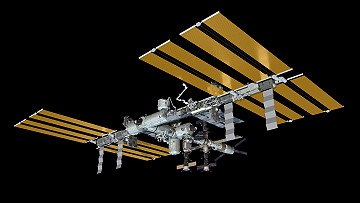 |
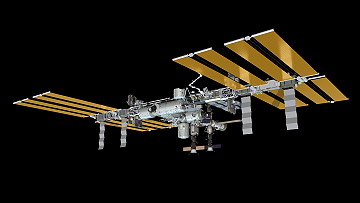 |
 |
 |
Photos
 |
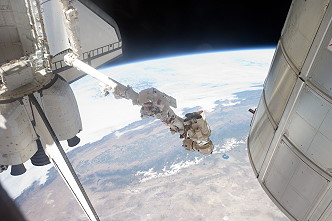 |
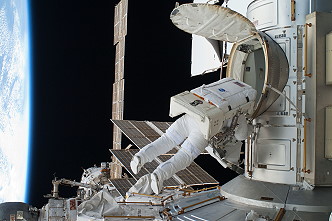 |
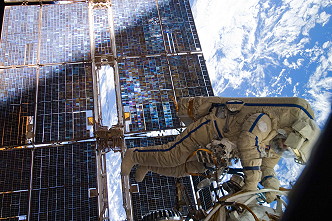 |
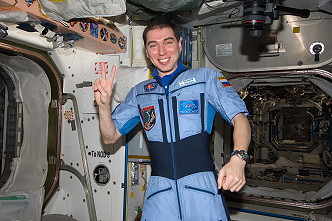 |
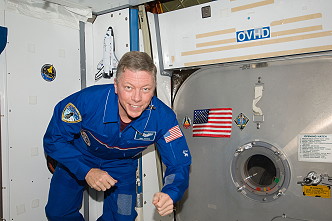 |
 |
 |
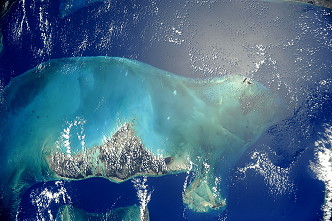 |
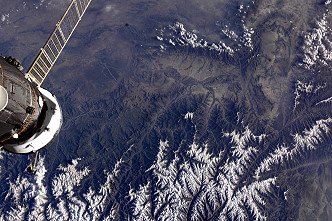 |
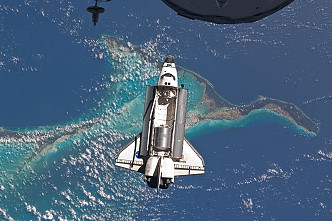 |
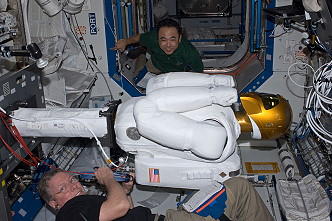 |
more Earth observation photos |
|
more EVA photos |
|
more onboard photos |
|
| © |  |
Last update on November 10, 2023.  |
 |